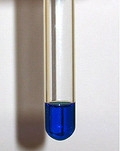

This is to avoid black stains on the tooth. The addition of solution (2) is to remove the excess silver ions that may form the dark silver phosphates. So, the possible by-products could be Calcium ions, fluoride ions, ammonium ions, silver ions, silver phosphate. A precipitation reaction involves the formation of an insoluble product or products from the reaction of soluble reactants. in the predicted and the actual mass And the precipitated forms. A precipitate is a solid compound that comes out of a solution, due to either physical changes in the solution or to chemical changes that form a new compound.

The silver ions also react with the tooth structure to form the dark black silver phosphates. It has been postulated that the fluoride usually reacts with hydroxyapatite, by replacing the calcium to form fluoroapatite, while the silver diamine exerts an antibacterial effect. When solution (1) is first applied to the tooth, the high pH has been shown to aid in the formation of covalent bonds of phosphate groups onto proteins and crystallites to grow. Tooth: Consists of collagen, proteins, hydroxyapatite, bacteria. Solution (2): Potassium iodide has a pH of 7. Solution (1): Silver diamine fluoride has a pH of 10. Riva Star comes in 2 solutions that are mixed together in the tooth cavity. There is some cool chemistry going on here but I am unsure what it is. The excess solution in the tooth cavity is then rinsed off with water. To add further to your question, for a silver diamine dental product (Riva Star by SDI), the white precipitate disappears after applying more potassium iodide to the mixture. I assume that the original silver solution was the diammine complex to prevent silver chloride from precipitating as soon as chloride ions are added (due to not perfectly deionised water being used). There are many other factors that can affect solubility, but these rules are a good first step to determine the outcome of aqueous solution reactions.The yellow precipitate that forms is silver(I) iodide, $\ce$$ The solubility rules are a useful guideline to predict whether a compound will dissolve or form a precipitate. When metal ions combine with the hydroxide ions (OH-) from either sodium hydroxide solution or ammonia solution, they form insoluble precipitates. The finished reaction is:Ģ KCl(aq) + Pb(NO 3) 2(aq) → 2 KNO 3(aq) + PbCl 2(s) This means PbCl 2 is insoluble and form a precipitate. Chlorides are soluble in water with the exception of silver, lead and mercury. KNO 3 will remain in solution since all nitrates are soluble in water. This can occur when an insoluble substance, the precipitate, is formed in the solution due to a reaction or when the solution has been supersaturated by a compound. When the chemical reaction occurs the solid formed is called the precipitate. The products should rearrange the ions to: Precipitation is the formation of a solid in a solution during a chemical reaction. What would be the expected products and will a precipitate form? The resulting balanced reaction would be:Ģ AgNO 3(aq) + MgBr 2 → 2 AgBr(s) + Mg(NO 3) 2(aq) The other compound Mg(NO 3) 2 will remain in solution because all nitrates, (NO 3) -, are soluble in water. Are the products soluble in water?Īccording to the solubility rules, all silver salts are insoluble in water with the exception of silver nitrate, silver acetate and silver sulfate.

The state of the products needs to be determined. The balanced reaction would be:Ģ AgNO 3(aq) + MgBr 2 → 2 AgBr(?) + Mg(NO 3) 2(?) For example, a silver nitrate solution (AgNO 3) is mixed with a solution of magnesium bromide (MgBr 2). The question remains, will AD or CB remain in solution or form a solid precipitate?Ī precipitate will form if the resulting compound is insoluble in water. This reaction is generally a double replacement reaction in the form: The process that forms a precipitate is called precipitation. When two aqueous solutions are mixed, the ions interact to form products. A precipitate is an insoluble compound that is formed in a liquid solution by mixing two soluble salts together. These solutions are represented in chemical equations in the form: AB(aq) where A is the cation and B is the anion.
#PRECIPITATE FORMED HOW TO#
This guide will show how to use the solubility rules for inorganic compounds to predict whether or not the product will remain in solution or form a precipitate.Īqueous solutions of ionic compounds are comprised of the ions making up the compound dissociated in water. When two aqueous solutions of ionic compounds are mixed together, the resulting reaction may produce a solid precipitate.


 0 kommentar(er)
0 kommentar(er)
